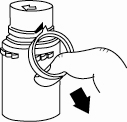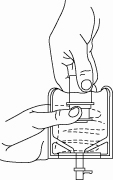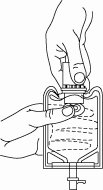CEFAZOLIN
-
cefazolin sodium injection, powder, lyophilized, for solution
AbbVie Inc.
----------
To reduce the development of drug-resistant bacteria and maintain the effectiveness of cefazolin and other antibacterial drugs, cefazolin should be used only to treat or prevent infections that are proven or strongly suspected to be caused by bacteria.
DESCRIPTION
Cefazolin for injection is a sterile, semi-synthetic cephalosporin for intravenous or intramuscular administration. It is the sodium salt of 3-{[(5-methyl-1,3,4-thiadiazol-2-yl)thio]-methyl}-8-oxo-7-[2-(1H-tetrazol-1-yl) acetamido]-5-thia-1-azabicyclo[4.2.0]oct-2-ene-2-carboxylic acid.
Its molecular formula is C14H13N8NaO4S3 and the molecular weight is 476.50.
Each vial contains 48 mg of sodium/1 gram of cefazolin sodium.
Cefazolin for injection is supplied as a lyophilized form.
Each ADD-Vantage® vial of cefazolin for injection is equivalent to 1 gram cefazolin.
CLINICAL PHARMACOLOGY
Human Pharmacology
After intramuscular administration of cefazolin to normal volunteers, the mean serum concentrations were 37 mcg/mL at one hour and
3 mcg/mL at eight hours following a 500 mg dose, and 64 mcg/mL at one hour and
7 mcg/mL at eight hours following a 1 gram dose.
Studies have shown that following intravenous administration of cefazolin to normal volunteers, mean serum concentrations peaked at approximately 185 mcg/mL and were approximately 4 mcg/mL at eight hours for a 1 gram dose.
The serum half-life for cefazolin is approximately 1.8 hours following I.V. administration and approximately 2.0 hours following I.M. administration.
In a study (using normal volunteers) of constant intravenous infusion with dosages of 3.5 mg/kg for one hour (approximately 250 mg) and 1.5 mg/kg the next two hours (approximately 100 mg), cefazolin produced a steady serum level at the third hour of approximately 28 mcg/mL.
Studies in patients hospitalized with infections indicate that cefazolin produces mean peak serum levels approximately equivalent to those seen in normal volunteers.
Bile levels in patients without obstructive biliary disease can reach or exceed serum levels by up to five times; however, in patients with obstructive biliary disease, bile levels of cefazolin are considerably lower than serum levels (< 1.0 mcg/mL).
In synovial fluid, the cefazolin level becomes comparable to that reached in serum at about four hours after drug administration.
Studies of cord blood show prompt transfer of cefazolin across the placenta. Cefazolin is present in very low concentrations in the milk of nursing mothers.
Cefazolin is excreted unchanged in the urine. In the first six hours approximately 60% of the drug is excreted in the urine and this increases to 70%-80% within 24 hours. Cefazolin achieves peak urine concentrations of approximately 2400 mcg/mL and 4000 mcg/mL respectively following 500 mg and 1 gram intramuscular doses.
In patients undergoing peritoneal dialysis (2 L/hr.), cefazolin produced mean serum levels of approximately 10 and 30 mcg/mL after 24 hours’ instillation of a dialyzing solution containing 50 mg/L and 150 mg/L, respectively. Mean peak levels were 29 mcg/mL (range 13-44 mcg/mL) with 50 mg/L (three patients), and 72 mcg/mL (range 26-142 mcg/mL) with 150 mg/L (six patients). Intraperitoneal administration of cefazolin is usually well tolerated.
Controlled studies on adult normal volunteers, receiving 1 gram 4 times a day for 10 days, monitoring CBC, SGOT, SGPT, bilirubin, alkaline phosphatase, BUN, creatinine and urinalysis, indicated no clinically significant changes attributed to cefazolin.
Microbiology
In vitro tests demonstrate that the bactericidal action of cephalosporins results from inhibition of cell wall synthesis. Cefazolin is active against the following organisms in vitro and in clinical infections:
Staphylococcus aureus (including penicillinase-producing strains)
Methicillin-resistant staphylococci are uniformly resistant to cefazolin
Group A beta-hemolytic streptococci and other strains of streptococci (many strains of enterococci are resistant)
Most strains of indole positive Proteus (Proteus vulgaris), Enterobactercloacae, Morganella morganii and Providencia rettgeri are resistant. Serratia, Pseudomonas, Mima, Herellea species are almost uniformly resistant to cefazolin.
Disk diffusion technique
— Quantitative methods that require measurement of zone diameters give the most precise estimates of antibiotic susceptibility. One such procedure1 has been recommended for use with disks to test susceptibility to cefazolin.
Reports from a laboratory using the standardized single-disk susceptibility test1 with a 30 mcg cefazolin disk should be interpreted according to the following criteria:
Susceptible organisms produce zones of 18 mm or greater, indicating that the tested organism is likely to respond to therapy.
Organisms of intermediate susceptibility produce zones 15 to 17 mm, indicating that the tested organism would be susceptible if high dosage is used or if the infection is confined to tissues and fluids (e.g., urine), in which high antibiotic levels are attained.
Resistant organisms produce zones of 14 mm or less, indicating that other therapy should be selected.
For gram-positive isolates, a zone of 18 mm is indicative of a cefazolin-susceptible organism when tested with either the cephalosporin-class disk (30 mcg cephalothin) or the cefazolin disk (30 mcg cefazolin).
Gram-negative organisms should be tested with the cefazolin disk (using the above criteria), since cefazolin has been shown by in vitro tests to have activity against certain strains of Enterobacteriaceae found resistant when tested with the cephalothin disk. Gram-negative organisms having zones of less than 18 mm around the cephalothin disk may be susceptible to cefazolin.
Standardized procedures require use of control organisms. The 30 mcg cefazolin disk should give zone diameter between 23 and 29 mm for E. coli ATCC 25922 and between 29 and 35 mm for S. aureus ATCC 25923.
The cefazolin disk should not be used for testing susceptibility to other cephalosporins.
Dilution techniques
— A bacterial isolate may be considered susceptible if the minimal inhibitory concentration (MIC) for cefazolin is not more than 16 mcg per mL. Organisms are considered resistant if the MIC is equal to or greater than 64 mcg per mL.
The range of MIC’s for the control strains are as follows:
INDICATIONS AND USAGE
Cefazolin is indicated in the treatment of the following serious infections due to susceptible organisms:
RESPIRATORY TRACT INFECTIONS due to Streptococcus pneumoniae, Klebsiella species, Haemophilus influenzae, Staphylococcus aureus (penicillin-sensitive and penicillin-resistant) and group A beta-hemolytic streptococci.
Injectable benzathine penicillin is considered to be the drug of choice in treatment and prevention of streptococcal infections, including the prophylaxis of rheumatic fever.
Cefazolin is effective in the eradication of streptococci from the nasopharynx; however, data establishing the efficacy of cefazolin in the subsequent prevention of rheumatic fever are not available at present.
URINARY TRACT INFECTIONS due to Escherichia coli, Proteus mirabilis, Klebsiella species and some strains of enterobacter and enterococci.
SKIN AND SKIN STRUCTURE INFECTIONS due to Staphylococcusaureus (penicillin-sensitive and penicillin-resistant), group A beta-hemolytic streptococci and other strains of streptococci.
BILIARY TRACT INFECTIONS due to Escherichiacoli, various strains of streptococci, Proteus mirabilis, Klebsiella species and Staphylococcusaureus.
BONE AND JOINT INFECTIONS due to Staphylococcus aureus.
GENITAL INFECTIONS (i.e., prostatitis, epididymitis) due to Escherichia coli, Proteusmirabilis, Klebsiella species and some strains of enterococci.
SEPTICEMIA due to Streptococcus pneumoniae, Staphylococcus aureus (penicillin-sensitive and penicillin-resistant), Proteus mirabilis, Escherichia coli and Klebsiella species.
ENDOCARDITIS due to Staphylococcus aureus (penicillin-sensitive and penicillin-resistant) and group A beta-hemolytic streptococci.
Appropriate culture and susceptibility studies should be performed to determine susceptibility of the causative organism to cefazolin.
PERIOPERATIVE PROPHYLAXIS: The prophylactic administration of cefazolin preoperatively, intraoperatively and postoperatively may reduce the incidence of certain postoperative infections in patients undergoing surgical procedures which are classified as contaminated or potentially contaminated (e.g., vaginal hysterectomy, and cholecystectomy in high-risk patients such as those over 70 years of age, with acute cholecystitis, obstructive jaundice or common duct bile stones).
The perioperative use of cefazolin may also be effective in surgical patients in whom infection at the operative site would present a serious risk (e.g., during open-heart surgery and prosthetic arthroplasty).
The prophylactic administration of cefazolin should usually be discontinued within a 24-hour period after the surgical procedure. In surgery where the occurrence of infection may be particularly devastating (e.g., open-heart surgery and prosthetic arthroplasty), the prophylactic administration of cefazolin may be continued for 3 to 5 days following the completion of surgery.
If there are signs of infection, specimens for cultures should be obtained for the identification of the causative organism so that appropriate therapy may be instituted.
(See DOSAGE AND ADMINISTRATION.)
To reduce the development of drug-resistant bacteria and maintain the effectiveness of cefazolin, and other antibacterial drugs, cefazolin should be used only to treat or prevent infections that are proven or strongly suspected to be caused by susceptible bacteria. When culture and susceptibility information are available, they should be considered in selecting or modifying antibacterial therapy. In the absence of such data, local epidemiology and susceptibility patterns may contribute to the empiric selection of therapy.
CONTRAINDICATIONS
CEFAZOLIN IS CONTRAINDICATED IN PATIENTS WITH KNOWN ALLERGY TO THE CEPHALOSPORIN GROUP OF ANTIBIOTICS.
BEFORE THERAPY WITH CEFAZOLIN IS INSTITUTED, CAREFUL INQUIRY SHOULD BE MADE TO DETERMINE WHETHER THE PATIENT HAS HAD PREVIOUS HYPERSENSITIVITY REACTIONS TO CEFTAZIDIME, CEPHALOSPORINS, PENICILLINS, OR OTHER DRUGS. IF THIS PRODUCT IS TO BE GIVEN TO PENICILLIN-SENSITIVE PATIENTS, CAUTION SHOULD BE EXERCISED BECAUSE CROSS-HYPERSENSITIVITY AMONG BETA-LACTAM ANTIBIOTICS HAS BEEN CLEARLY DOCUMENTED AND MAY OCCUR IN UP TO 10% OF PATIENTS WITH A HISTORY OF PENICILLIN ALLERGY. IF AN ALLERGIC REACTION TO CEFAZOLIN OCCURS, DISCONTINUE THE DRUG. SERIOUS ACUTE HYPERSENSITIVITY REACTIONS MAY REQUIRE TREATMENT WITH EPINEPHRINE AND OTHER EMERGENCY MEASURES, INCLUDING OXYGEN, IV FLUIDS, IV ANTIHISTAMINES, CORTICOSTEROIDS, PRESSOR AMINES, AND AIRWAY MANAGEMENT, AS CLINICALLY INDICATED.
Pseudomembranous colitis has been reported with nearly all antibacterial agents, including cefazolin, and may range in severity from mild to life-threatening. Therefore, it is important to consider this diagnosis in patients who present with diarrhea subsequent to the administration of antibacterial agents.
Treatment with antibacterial agents alters the normal flora of the colon and may permit overgrowth of clostridia. Studies indicate that a toxin produced by Clostridiumdifficile is one primary cause of ‘‘antibiotic-associated colitis.’’
After the diagnosis of pseudomembranous colitis has been established, therapeutic measures should be initiated. Mild cases of pseudomembranous colitis usually respond to drug discontinuation alone. In moderate to severe cases, consideration should be given to management with fluids and electrolytes, protein supplementation and treatment with an antibacterial drug clinically effective against C. difficile colitis.
PRECAUTIONS
General
— Prolonged use of cefazolin may result in the overgrowth of nonsusceptible organisms. Careful clinical observation of the patient is essential.
When cefazolin is administered to patients with low urinary output because of impaired renal function, lower daily dosage is required.
(See DOSAGE AND ADMINISTRATION.)
As with other beta-lactam antibiotics, seizures may occur if inappropriately high doses are administered to patients with impaired renal function.
(See DOSAGE AND ADMINISTRATION.)
Cefazolin, as with all cephalosporins, should be prescribed with caution in individuals with a history of gastrointestinal disease, particularly colitis.
Cephalosporins may be associated with a fall in prothrombin activity. Those at risk include patients with renal or hepatic impairment or poor nutritional state, as well as patients receiving a protracted course of antimicrobial therapy, and patients previously stabilized on anticoagulant therapy. Prothrombin time should be monitored in patients at risk and exogenous vitamin K administered as indicated.
Prescribing cefazolin in the absence of a proven or strongly suspected bacterial infection or a prophylactic indication is unlikely to provide benefit to the patient and increases the risk of the development of drug-resistant bacteria.
Drug Interactions
— Probenecid may decrease renal tubular secretion of cephalosporins when used concurrently, resulting in increased and more prolonged cephalosporin blood levels.
Drug/Laboratory Test Interactions
— A false positive reaction for glucose in the urine may occur with Benedict’s solution, Fehling’s solution or with Clinitest® tablets, but not with enzyme-based tests such as Clinistix®.
Positive direct and indirect antiglobulin (Coombs) tests have occurred; these may also occur in neonates whose mothers received cephalosporins before delivery.
Information for Patients
Patients should be counseled that antibacterial drugs including cefazolin, should only be used to treat bacterial infections. They do not treat viral infections (e.g., the common cold). When cefazolin is prescribed to treat a bacterial infection, patients should be told that although it is common to feel better early in the course of therapy, the medication should be taken exactly as directed. Skipping doses or not completing the full course of therapy may: (1) decrease the effectiveness of the immediate treatment, and (2) increase the likelihood that bacteria will develop resistance and will not be treatable by cefazolin or other antibacterial drugs in the future.
Carcinogenesis/Mutagenesis
— Mutagenicity studies and long-term studies in animals to determine the carcinogenic potential of cefazolin have not been performed.
Pregnancy
— Teratogenic Effects—Pregnancy Category B. Reproduction studies have been performed in rats, mice and rabbits at doses up to 25 times the human dose and have revealed no evidence of impaired fertility or harm to the fetus due to cefazolin. There are, however, no adequate and well-controlled studies in pregnant women. Because animal reproduction studies are not always predictive of human response, this drug should be used during pregnancy only if clearly needed.
Labor and Delivery
— When cefazolin has been administered prior to caesarean section, drug levels in cord blood have been approximately one quarter to one third of maternal drug levels. The drug appears to have no adverse effect on the fetus.
ADVERSE REACTIONS
The following reactions have been reported:
Gastrointestinal
Diarrhea, oral candidiasis (oral thrush), vomiting, nausea, stomach cramps, anorexia and pseudomembranous colitis. Onset of pseudomembranous colitis symptoms may occur during or after antibiotic treatment (see WARNINGS). Nausea and vomiting have been reported rarely.
Allergic: Anaphylaxis, eosinophilia, itching, drug fever, skin rash, Stevens-Johnson syndrome.
Hematologic
Neutropenia, leukopenia, thrombocytopenia, thrombocythemia.
Hepatic: Transient rise in SGOT, SGPT and alkaline phosphatase levels has been observed. As with other cephalosporins, reports of hepatitis have been received.
Renal
As with other cephalosporins, reports of increased BUN and creatinine levels, as well as renal failure, have been received.
DOSAGE AND ADMINISTRATION
NOTE: Cefazolin for injection in the ADD-Vantage® Vial is not intended for direct intravenous or intramuscular injection.
*In rare instances, doses of up to 12 grams of cefazolin per day have been used.
Perioperative Prophylactic Use
To prevent postoperative infection in contaminated or potentially contaminated surgery, recommended doses are:
a. 1 gram I.V. or I.M. administered 1/2 hour to 1 hour prior to the start of surgery.
b. For lengthy operative procedures (e.g., 2 hours or more), 500 mg to 1 gram I.V. or I.M. during surgery (administration modified depending on the duration of the operative procedure).
c. 500 mg to 1 gram I.V. or I.M. every 6 to 8 hours for 24 hours postoperatively.
It is important that 1) the preoperative dose be given just (1/2 to 1 hour) prior to the start of surgery so that adequate antibiotic levels are present in the serum and tissues at the time of initial surgical incision; and 2) cefazolin be administered, if necessary, at appropriate intervals during surgery to provide sufficient levels of the antibiotic at the anticipated moments of greatest exposure to infective organisms.
In surgery where the occurrence of infection may be particularly devastating (e.g., open-heart surgery and prosthetic arthroplasty), the prophylactic administration of cefazolin may be continued for 3 to 5 days following the completion of surgery.
Dosage Adjustment for Patients with Reduced Renal Function
Cefazolin may be used in patients with reduced renal function with the following dosage adjustments: Patients with a creatinine clearance of 55 mL/min. or greater or a serum creatinine of 1.5 mg% or less can be given full doses. Patients with creatinine clearance rates of 35 to 54 mL/min. or serum creatinine of 1.6 to 3.0 mg% can also be given full doses but dosage should be restricted to at least 8 hour intervals. Patients with creatinine clearance rates of 11 to 34 mL/min. or serum creatinine of 3.1 to 4.5 mg% should be given 1/2 the usual dose every 12 hours. Patients with creatinine clearance rates of 10 mL/min. or less or serum creatinine of 4.6 mg% or greater should be given 1/2 the usual dose every 18 to 24 hours. All reduced dosage recommendations apply after an initial loading dose appropriate to the severity of the infection. Patients undergoing peritoneal dialysis: See Human Pharmacology.
In pediatric patients, a total daily dosage of 25 to 50 mg per kg (approximately 10 to 20 mg per pound) of body weight, divided into three or four equal doses, is effective for most mild to moderately severe infections. Total daily dosage may be increased to 100 mg per kg (45 mg per pound) of body weight for severe infections. Since safety for use in premature infants and in neonates has not been established, the use of cefazolin in these patients is not recommended.
In pediatric patients with mild to moderate renal impairment (creatinine clearance of 70 to 40 mL/min.), 60 percent of the normal daily dose given in equally divided doses every 12 hours should be sufficient. In patients with moderate impairment (creatinine clearance of 40 to 20 mL/min.), 25 percent of the normal daily dose given in equally divided doses every 12 hours should be adequate. Pediatric patients with severe renal impairment (creatinine clearance of 20 to 5 mL/min.) may be given 10 percent of the normal daily dose every 24 hours. All dosage recommendations apply after an initial loading dose.
RECONSTITUTION
Preparation of Parenteral Solution
Parenteral drug products should be SHAKEN WELL when reconstituted, and inspected visually for particulate matter and discoloration prior to administration. If particulate matter is evident in reconstituted fluids, the drug solutions should be discarded.
When reconstituted or diluted according to the instructions below, cefazolin for injection is stable for 24 hours at room temperature. Reconstituted solutions may range in color from pale yellow to yellow without a change in potency.
ADD-Vantage® Vials of cefazolin for injection are to be reconstituted only with 0.9% Sodium Chloride Injection or 5% Dextrose Injection in the 50 mL or 100 mL ADD-Vantage® Flexible Diluent Containers or with 0.45% Sodium Chloride Injection in the 50 mL ADD-Vantage® Flexible Diluent Container. Cefazolin for injection supplied in single-dose ADD-Vantage® Vials should be prepared as directed below.
INSTRUCTIONS FOR USE
Peel overwrap at corner and remove solution container. Some opacity of the plastic due to moisture absorption during the sterilization process may be observed. This is normal and does not affect the solution quality or safety. The opacity will diminish gradually.
To Assemble Vial and Flexible Diluent Container:
1. Remove the protective covers from the top of the vial and the vial port on the diluent container as follows:
a.To remove the breakaway vial cap, swing the pull ring over the top of the vial and pull down far enough to start the opening (SEE FIGURE 1), then pull straight up to remove the cap (SEE FIGURE 2).
NOTE: Once the breakaway cap has been removed, do not access vial with syringe.
b. To remove the vial port cover, grasp the tab on the pull ring, pull up to break the three tie strings, then pull back to remove the cover (SEE FIGURE 3).
2.Screw the vial into the vial port until it will go no further. THE VIAL MUST BE SCREWED IN TIGHTLY TO ASSURE A SEAL. This occurs approximately 1/2 turn (180°) after the first audible click (SEE FIGURE 4). The clicking sound does not assure a seal; the vial must be turned as far as it will go.
NOTE: Once vial is seated, do not attempt to remove (SEE FIGURE 4).
3. Recheck the vial to assure that it is tight by trying to turn it further in the direction of assembly.
- Squeeze the bottom of the diluent container gently to inflate the portion of the container surrounding the end of the drug vial.
- With the other hand, push the drug vial down into the container telescoping the walls of the container. Grasp the inner cap of the vial through the walls of the container (SEE FIGURE 5).
- Pull the inner cap from the drug vial (SEE FIGURE 6). Verify that the rubber stopper has been pulled out, allowing the drug and diluent to mix.
- Mix container contents thoroughly and use within the specified time.
Preparation for Administration:
- Confirm the activation and admixture of vial contents.
- Check for leaks by squeezing container firmly. If leaks are found, discard unit as sterility may be impaired.
- Close flow control clamp of administration set.
- Remove cover from outlet port at bottom of container.
- Insert piercing pin of administration set into port with a twisting motion until the pin is firmly seated. NOTE: See full directions on administration set carton.
- Lift the free end of the hanger loop on the bottom of the vial, breaking the two tie strings. Bend the loop outward to lock it in the upright position, then suspend container from hanger.
- Squeeze and release drip chamber to establish proper fluid level in chamber.
- Open flow control clamp and clear air from set. Close clamp.
- Attach set to venipuncture device. If device is not indwelling, prime and make venipuncture.
- Regulate rate of administration with flow control clamp.
WARNING: Do not use flexible container in series connections.
Ordinarily ADD-Vantage® Vials should be reconstituted only when it is certain that the patient is ready to receive the drug. However, cefazolin for injection in ADD-Vantage® vials is stable for 24 hours at room temperature when reconstituted as directed (see RECONSTITUTION, ADD-Vantage® Vials and INSTRUCTIONS FOR USE). (DO NOT REFRIGERATE OR FREEZE CEFAZOLIN SODIUM IN ADD-VANTAGE® VIALS.)
HOW SUPPLIED
Cefazolin for injection is supplied in ADD-Vantage® Vials equivalent to 1 gram of cefazolin in packages of 25 (NDC 0074-4732-03).
As with other cephalosporins, cefazolin for injection tends to darken depending on storage conditions; within the stated recommendations, however, product potency is not adversely affected.
Before reconstitution, protect from light and store at Controlled Room Temperature 20° to 25°C (68° to 77°F).
REFERENCE
1Bauer, A.W.; Kirby, W.M.M.; Sherris, J.C., and Turck, M.: Antibiotic Testing by a Standardized Single Disc Method, Am. J. Clin. Path. 45:493, 1966. Standardized Disc Susceptibility Test, Federal Register 39:19182-19184, 1974.
CE:L7AV685651/58-7297-R8-Rev. FEB. 2004
| CEFAZOLIN
cefazolin injection, powder, lyophilized, for solution |
||||||||||||||||||
|
||||||||||||||||||
|
||||||||||||||||||
|
||||||||||||||||||
|
||||||||||||||||||
| Marketing Information | |||
| Marketing Category | Application Number or Monograph Citation | Marketing Start Date | Marketing End Date |
| ANDA | ANDA064033 | 10/31/1993 | 01/14/2013 |
| Labeler - AbbVie Inc. (078458370) |
Revised: 01/2013 AbbVie Inc.







